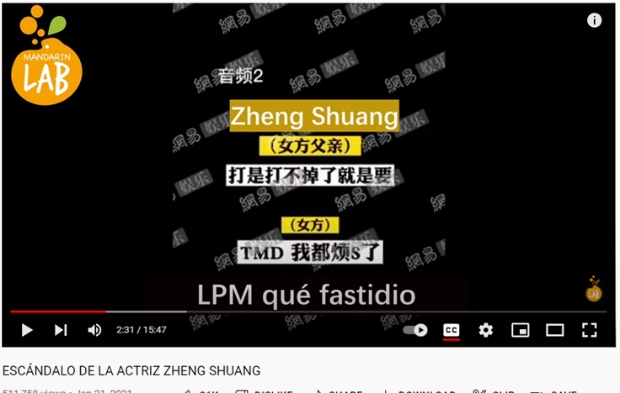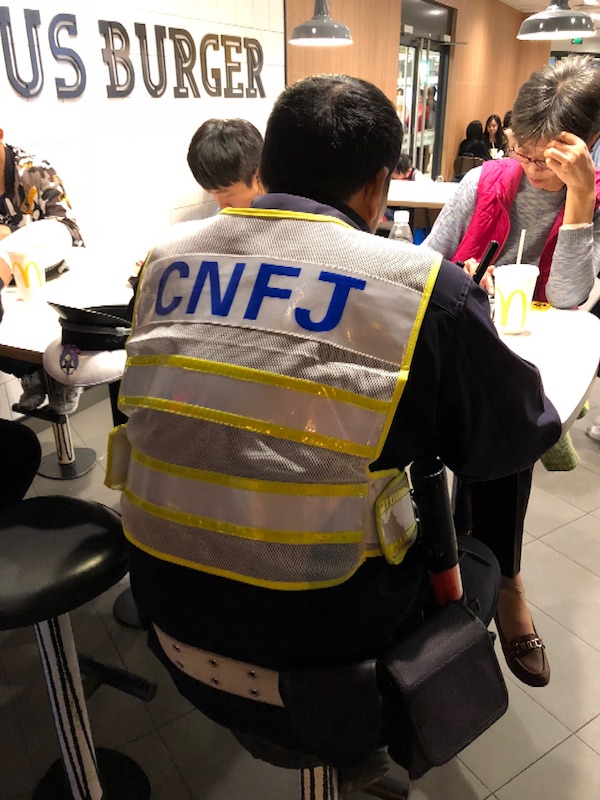Archive for Acronyms
December 2, 2023 @ 8:37 am· Filed by Victor Mair under Acronyms, Borrowing, Grammar, Language and entertainment, Language and sports, Word of the year
Japanese words of the year are always exciting and surprising, but this year's takes the cake.
are あれ
pronunciation
distal demonstrative, something far off removed from both speaker and listener: that, yon
-
- (deictically) that one over there (far from the speaker and the addressee)
- あれはなんですか?
- Are wa nan desu ka?
- What is that?
- (anaphorically) that one we both know (both the speaker and the addressee know)
- これはあれでしょ?○○。
- Kore wa are desho?○○.
- This is that one thing, isn't it? You know, X.
Usage note
-
- Indicates something far off, removed from both speaker and addressee. Contrast with それ (sore), indicating something removed from the speaker but closer to the addressee.
(Wiktionary)
Read the rest of this entry »
Permalink
November 2, 2023 @ 4:23 am· Filed by Victor Mair under Acronyms, Language and culture, Language play
As Laura Morland said to me in a p.c., I am a "Swiftie" (I admit it, even though I'm a Penn prof), but there are plenty of things about pop culture that I do not know, including IJBOL.
What Is IJBOL?
A Korean word? A new boy band? This new acronym is replacing LOL and ROFL on social media.
By Shirley Wang, NYT
Published Aug. 8, 2023
——-
First there was LOL (“laugh out loud”), an acronym that first appeared in the 1980s and became the reigning shorthand online for what people found funny. Then came ROFL (“rolling on the floor laughing”), LMAO (“laughing my ass off”) and even nonverbal cues like smiling emojis. Still, most type these terms straight-faced, relegating them to dull punctuation added carelessly to the end of a message. Now, the internet wants to revitalize laughing online with a new term: IJBOL.
Read the rest of this entry »
Permalink
February 16, 2023 @ 7:58 pm· Filed by Victor Mair under Acronyms, Names, Phonetics and phonology, Pronunciation
Yesterday, Charlie Munger, the 99-year-old billionaire Vice Chairman of Berkshire Hathaway, declared that the Chinese company, BYD, was beating Tesla in the electric vehicle (EV) market. I had never heard of BYD, so I asked my students from mainland China what "BYD" meant.
They all seemed to consider the apparent initialism as though it were an English word, pronouncing it Beeyah'di, making the second syllable long and stressed. I pursued by asking, "But what does it mean? What does it stand for?"
They said, "It doesn't mean anything and it doesn't stand for anything. It's just the name of a car company: Beeyah'di."
Read the rest of this entry »
Permalink
January 9, 2023 @ 7:11 pm· Filed by Victor Mair under Acronyms, Language and religion, Language and the movies, Memorization
From TIC Redux:
In the 1971 British dark comedy horror film "The Abominable Dr. Phibes", the title character (played by a scenery-chewing Vincent Price) elaborately kills his victims through torturous deaths inspired by the ten (or so?) Plagues of Egypt… More than once in the film, those biblical plagues are referred to (per closed-captioning) as "the G'Tach"… That term intrigues me, but I've never been able to find any uses of, or references to, it except in connection with this film… Is it a real word?…
Read the rest of this entry »
Permalink
June 25, 2022 @ 4:58 pm· Filed by Victor Mair under Acronyms, Code switching, Mixed lanuage, Multilingualism, Slang, Writing
[This is a guest post by Conal Boyce]
A tale of five mothers, two of whom got rich, one of whom became infamous,
and two of whom were to meet each other later in the bilingual alphabet soup shown below.
(Suitable for playing "This little piggy went to market, and this little piggy…"?)

Read the rest of this entry »
Permalink
October 24, 2021 @ 2:18 pm· Filed by Victor Mair under Acronyms, Alphabets, Diglossia and digraphia, Writing systems
Since the vast majority of inputting in the PRC is done via Hanyu Pinyin, netizens are thoroughly familiar with the alphabet and use it regularly as part of the Chinese writing system.
One common usage for the alphabet in the PRC is acronymically to designate frequently encountered Mandarin phrases. In "The Chinese Internet Slang You Need to Know in 2021", CLI (10/19/21), Anias Stambolis-D'Agostino introduces six popular online acroyms:
1. yyds (永远的神)
永远的神 (yǒngyuǎn de shén; yyds) means “eternal God” and describes an outstanding person or thing. It's similar to the saying GOAT (Greatest of All Time) in English. The phrase is often used by fans to praise their idols or simply to describe something they are fond of.
For example:
-
- 桂林米粉太好吃了,桂林米粉就是yyds!
- Guìlín mǐfěn tài hàochī le, Guìlín mǐfěn jiùshì yyds.
- Guilin rice noodles are delicious, they’re just yyds!
Here's another example:
-
- 李小龙的中国功夫太厉害了,他就是yyds!
- Lǐxiǎolóng de Zhōngguó gōngfū tài lìhài le, tā jiùshì yyds
- Bruce Li’s kung fu skills are so good, he’s such a yyds!
Read the rest of this entry »
Permalink
December 23, 2019 @ 9:53 am· Filed by Victor Mair under Abbreviation, Acronyms, Diglossia and digraphia, Idioms, Romanization
Literary Sinitic / Classical Chinese has an extreme propensity for elision, truncation, and abbreviation, which is one of the factors that make it so hard to read.
Yesterday, we looked at the current Chinese proclivity for acronyms and initialisms, made much easier to produce and apply due to the use of digital technology and pinyin as part of an emerging Sinitic digraphia. See "Chinese acronyms" (12/22/19).
In recent years, a new kind of quadrisyllabic "set phrase" has arisen in internet usage, one not based on historical allusion or other traditional source. Here are seven typical examples:
Read the rest of this entry »
Permalink
December 22, 2019 @ 8:30 am· Filed by Victor Mair under Acronyms, Bilingualism, Borrowing, Diglossia and digraphia, Language and computers, Metaphors, Romanization
Apollo Wu sent in this list of what he calls "Chinese acronyms" (Romanizations, translations, links, and comments are by VHM):
GJBZ 国家标准 Guójiā biāozhǔn ("National Standard") — this is commonly reduced still further to "GB"
YDYL 一带一路 Yīdài yīlù ("One Belt, One Road" or "Belt and Road")
RMB 人民币 Rénmínbì ("RMB", the Chinese yuan)
Read the rest of this entry »
Permalink
November 6, 2019 @ 7:00 pm· Filed by Victor Mair under Abbreviation, Acronyms, Alphabets, Diglossia and digraphia, Writing systems
Jeff DeMarco writes:
I have just come across some mixed language abbreviations on Chinese social media. For example, 川A市 refers to Chengdu. 皖J市 is Huangshan in Anhui, and 皖A市 is Chaohu.
I am curious as to how the letters are assigned.
The incorporation of the Roman alphabet into the Chinese writing system is a topic that we have often addressed on Language Log, for which see the "Readings" (and the bibliographies they include) below.
Read the rest of this entry »
Permalink
November 2, 2019 @ 5:47 am· Filed by Victor Mair under Acronyms, Language on the internets, Writing systems
Recently, one of my students found an interesting post from the Communist Youth League about the use of Hanyu Pinyin acronyms on the Internet. When people type on Weibo, WeChat, and other social media, they frequently use Pinyin acronyms. For examples:
Read the rest of this entry »
Permalink
August 2, 2019 @ 11:05 am· Filed by Mark Liberman under Acronyms, Computational linguistics
In "Contextualized Muppet Embeddings" (2/13/2019) I noted the advent of ELMo ("Embeddings from Language Models") and BERT ("Bidirectional Encoder Representations from Transformers"), and predicted ERNiE, GRoVEr, KERMiT, …
I'm happy to say that the first of these predictions has come true:
"Baidu’s ERNIE 2.0 Beats BERT and XLNet on NLP Benchmarks", Synced 7/30/2019
"Baidu unveils ERNIE 2.0 natural language framework in Chinese and English", VentureBeat 7/30/2019
Actually I'm late reporting this, since ERNIE 1.0 came out in March:
"Baidu’s ERNIE Tops Google’s BERT in Chinese NLP Tasks", Synced 3/25/2019
But I'm ashamed to say that the Open System for Classifying Ambiguous Reference (OSCAR) is still just an idea, though I did recruit a collaborator who agreed in principle to work with me on it.
Permalink
March 13, 2019 @ 12:07 am· Filed by Victor Mair under Acronyms, Bilingualism, Pronunciation, Puns
Thomas Lumley called my attention to the neologism and bilingual pun "whaumau", now a Twitter hashtag:
Read the rest of this entry »
Permalink
November 3, 2018 @ 8:12 pm· Filed by Victor Mair under Acronyms, Borrowing, Diglossia and digraphia, Writing systems
Here we go again. More Roman letters and English words on police and security guard uniforms in China (see below for some earlier posts). Here's a doozy:

Read the rest of this entry »
Permalink

